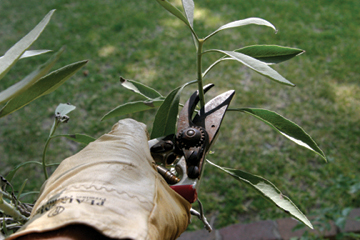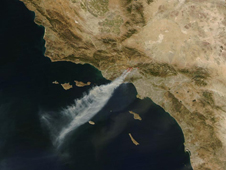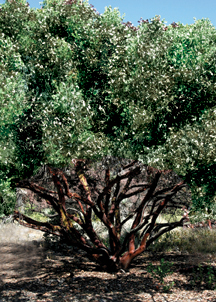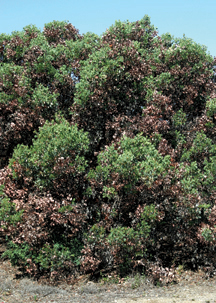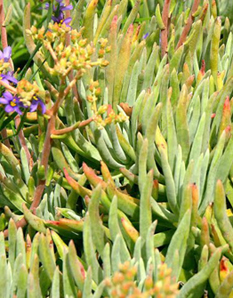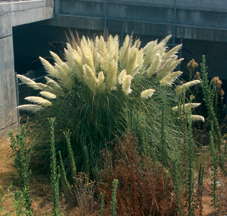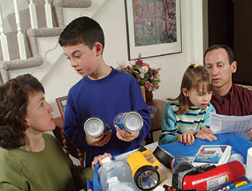In early summer, give your leaf blower a vacation; use a rake instead. Leaf blowers blow away mulch and topsoil, and they contribute to air and noise pollution. They are also a fire hazard due to engine heat and sparks.
REVIEW SUMMER VEGETATION MAINTENANCE
• Water appropriately to maintain healthy leaf moisture without encouraging excess growth.
• Hand-prune the inside branches of shrubs to reduce flush of growth. Remember, edging and shearing alone results in weak, fast growth and more fuel.
• Stay ahead of weeds by maintaining a regular schedule of hand pulling or weed whipping, before the seed heads mature, to reduce fire hazard and invasive seed banks.
· Utilize mulch to suppress weeds.
• Dry leaves and other debris that have collected in your rain gutters can be dangerous and ignite a fire very easily. Cleaning your rain gutters regularly can prevent this from being a threat.
· For general landscape maintenance and irrigation information, check out the Sunset Western Garden Book or Care and Maintenance of Southern California Native Plant Gardens.
SANTA ANA WINDS
The true onslaught of the east winds – Santa Anas - often begins in July and sometimes lasts into November or December. Santa Ana winds are strong, hot, very dry winds that sweep into Southern California from the east or northeast. When temperatures are warm and vegetation moisture is very low, these east winds create critically dangerous fire conditions.
Wind driven fires, October 2008. From NASA/MODIS
If winds exceed 25 mph and humidity is below 15%, the National Weather Service will issue a Red Flag warning. These are issued to make everyone aware of the hazard and to remind them to make preparations should they be asked to evacuate. If a wildfire occurs during a Santa Ana wind event, the fire can spread very rapidly. Some jurisdictions restrict parking on narrow streets on Red Flag days. This helps residents evacuate and fire companies gain access during a wildfire. If residents trying to evacuate become trapped in their vehicles, this can lead to a catastrophic situation. Be aware of Red Flag days and respect parking restrictions in posted locations.
Residents in the WUI should be prepared to evacuate if asked to do so by emergency personnel. Evacuations are ordered to save lives. Property can be replaced; lives can’t. If you choose to ignore an evacuation order to stay and defend your property, the fire department may not be able to assist you. Please contact your local fire department for more information about fire and wind conditions, and directions for how to respond.
PRUNING FOR HEALTHY PLANTS
Most plants will benefit from occasional corrective pruning, and all will benefit from the removal of dead wood. Time the pruning of individual plants over several years to allow them to recover. Try pruning about 1/3 of your plants in a given year, so that all are pruned at the end of three years.
Regularly remove dead material and branches from your trees and shrubs. For deciduous trees and shrubs, prune before they lose their leaves, when it is easier to see the dead branches.
Hand-prune inside branches to reduce flush of growth. Hedging and shearing alone results in weak, fast growth and more fuel.
On steep slopes, be sure to keep shrubs and trees (for example, Coast Live Oak) with deep root systems to help prevent erosion!
Before and after proper pruning of a manzanita
FIRE-RESISTANT PLANT CHARACTERISTICS When choosing plants or identifying which plants to keep when performing fuel modification, look for fire-resistant plants.
Fire-resistant plants:
Store water in leaves or stems
Produce very little dead or fine material
Possess extensive, deep root systems for controlling erosion
Maintain high moisture content with limited watering
Grow slowly and need little maintenance
Are low-growing in form
Contain low levels of volatile oils or resins
Have an open, loose branching habit with a low volume of total vegetation
Dudleya hassei, a fire-resistant Southern California native. Photo by D. Ready, LASGRWC
The moisture content of plants is an important consideration because high levels of plant moisture can lower fire risk and act as a heat sink, reducing the intensity and spread of fire.
CHARACTERISTICS OF FLAMMABLE PLANTS
Avoid purchasing or consider removing highly flammable plants.
Highly flammable plants:
Retain large amounts of dead material within the plant
Produce a large volume of litter
Contain volatile substances such as: oils, resins, wax, or pitch
Pampass grass is highly flammable, and highly invasive. Photo by J. DiTomaso, UC Davis
KEEP YOUR PROPERTY FIRE-SAFE WHEN ON VACATION
You can take a vacation this summer with few worries if you take some preventive measures before leaving to ensure your house is fire-safe.
• Close windows and shutters.
• Check your smoke detectors to make sure they are functioning when you return from vacation. Batteries could run down or other components could fail while you’re away.
• Check to make sure that all stoves have been turned off or disconnected.
• Turn off all unnecessary appliances and make sure everything that draws current is unplugged - lightning storms or sudden electrical surges could cause a fire in this equipment while you’re away.
• Put your irrigation system on a timer, or better yet, enlist someone to water your property when needed to help maintain plant health and fire resistance.
• Make sure all flammable materials are stored completely away from the exterior of your home.
· Leave your house and car keys as well as your contact information with a neighbor or relative in case of emergency.
FAMILY FIRE DRILL
Now is the time to create a fire escape plan for your family. Establish at least two exit paths out of each room, as well as a place away from the house where your family can meet once everyone is out of danger. In a multi-story house, consider roll-out evacuation ladders for upper-floor rooms.
Remember that a plan won’t help unless everyone in your family knows and understands it. Be sure to practice several times with a fire drill. Check with your local fire department for up-to-date fire drill procedures. Everyone who is capable needs to learn how to use the fire extinguisher. Be sure to practice several times. In an emergency situation, you need to act without hesitation, so if you have to stop and think about how to operate the extinguisher, you might not be able to control a fire in time. For information on different types of fire extinguishers, please visit www.fire-extinguisher101.com. Show every family member how to “stop, drop and roll.” This technique has been proven to be a life-saver.

